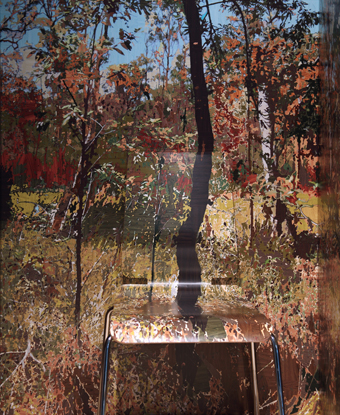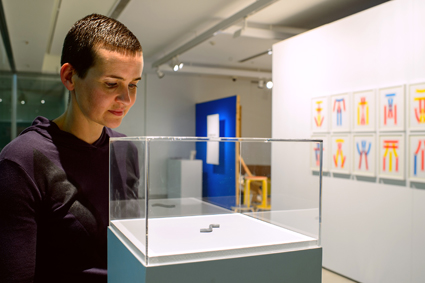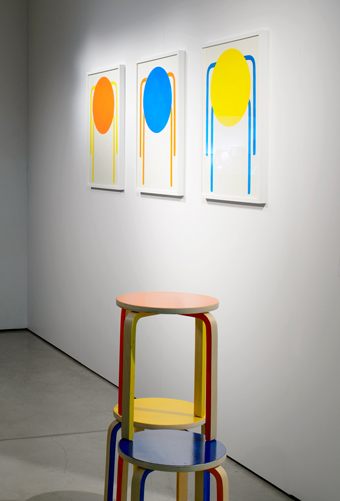things to do with ikea
ella mudie: swedish for argument, uts gallery

Gary Carsley, D.98b (UTS dub), (detail)
photo David Lawry
Gary Carsley, D.98b (UTS dub), (detail)
NOTWITHSTANDING ITS RATHER CRYPTIC TITLE, SWEDISH FOR ARGUMENT WAS AN INCISIVE AND ENTERTAINING GROUP EXHIBITION THAT CATALYSED THE MODEST SPACE OF THE UTS GALLERY TO TACKLE A GIANT, THAT UBIQUITOUS SWEDISH HOME RETAIL BRAND THAT EVERYONE LOVES TO HATE: IKEA.
Bringing together an eclectic mix of specially commissioned and pre-existing artworks from eight local and international artists, the exhibition presented a stimulating array of responses to the many facets of the brand from its ‘democratic design’ philosophy and complex global material supply chain to its tightly engineered retail spaces and the uses and abuses of its products by consumers. All this provided rich fodder for works across video, mixed media installations, sculpture, graphic design, conceptual interventions and even a hands-on re-purposing design workshop.
Given that artists can be ambivalent at best toward purveyors of mass production, I anticipated the show might prove fairly derisive in tone. Gladly, curator Holly Williams steered clear of reductive negativity in her selection of works with many revealing a surprising level of subtlety and nuance in their responses. Exemplary in this respect was Jess Olivieri’s video, Like A Salmon (2012). With a covert camera jerry-rigged to a shopping trolley, the artist and collaborators filmed a journey through an IKEA store, deliberately navigating its aisles against the directed flow of pedestrian traffic. The slightly nauseous sensation produced by this counter-intuitive movement drew attention to the highly controlled nature of the IKEA retail space. Yet the addition of some whimsical movements and a soothing classical music soundtrack reminiscent of those accompanying in nature documentaries combined to create a strangely mesmerising and dreamlike subliminal landscape.
The temptation to intervene into the IKEA retail space proved attractive to a number of artists. Israeli artist Guy Ben-Ner’s video Stealing Beauty (2007) presented an extreme example—a subversive, Marxist-inflected family drama compiled from unauthorised filming of the artist’s own family inhabiting various IKEA showrooms. More subtle was Michele Pred’s You Are What You Buy (2009), which saw the artist secretly replace 10 generic poster prints at a local IKEA with her own original artworks. Shoppers unwittingly bought Pred’s prints unaware of their provenance and the fact that when their QR code design was scanned it led directly to an anti-consumer website.

Emma White Nice Try, DIY 2012, polymer clay, object modelled to scale
photo David Lawry, courtesy the artist and BREENSPACE, Sydney
Emma White Nice Try, DIY 2012, polymer clay, object modelled to scale
Installation-based approaches took more material aspects of the IKEA experience as starting points for their investigations. Emma White’s fastidious silver polymer clay model of the Allen key ironically elevated this icon of self-assembly to the status of semi-precious object by presenting it on a tall white plinth encased in clear Perspex. Gary Carsley papered an exquisite photographic monoprint of an Australian bush landscape onto an IKEA stool, chair and a two-door wardrobe, seamlessly collaging the chair into the wardrobe to create a striking trompe l’oeil effect. This melding of a familiar Australian scene with iconic Swedish pinewood furniture provoked reflection on the displacement of the local in global supply chains and raised questions over the status of the ‘natural’ and the ‘real.’

Lorenzo Bravi, IKEA PRESS Frosta 1
photo David Lawrey
Lorenzo Bravi, IKEA PRESS Frosta 1
The title of Carsley’s work, D.98b (UTS dub), also cited the gallery’s location which sits within the UTS Faculty of Design, Architecture and Building. This design lab setting also offered an ideal context for artist and graphic designer Lorenzo Bravi’s IKEA Press series (2011-12). Comprising letterpress prints stamped from dismantled IKEA product parts and rendered in bold primary colours, Bravi’s prints were a playful and experimental response to the generative possibilities of modular design.
The setting was also cleverly activated by the IKEA Recovery Workshop. Prior to the exhibition, curator Holly Williams trawled Sydney streets to retrieve a stockpile of dumped IKEA furniture—offering a disturbing insight into the disposable mindset their low prices have engendered. Expanding their life span just a little longer, RMIT lecturer Scott Mitchell led a “re-purposing” workshop with staff and students combining ideas to transform the dumped items into makeshift furnishings that ranged from surprisingly elegant to more zany and unconventional solutions.
It seemed the workshop participants had more success with their building project than artist Tony Schwensen did in TransScandinavia (2006). In a video documentation of a live performance in which Schwensen attempted assembly of an IKEA flatpack wardrobe without instructions, his futile efforts lampooned the masculine ideal of the handyman. At the other end of the spectrum, Dutch artist Helmut Smits successfully put his fire-making skills to practical use in an urban survival scenario in FLAMMA (A Basic Need) (2008). In this no-fuss instructive documentary, Smits lit a crackling fire using only IKEA products (and no matches), a subtle satire of the “back-to-basics” image of Swedish culture.
Overall, there were many charming details in Swedish for Argument. IKEA product tags stood in for wall plaques, IKEA couches and chairs were dispersed throughout the space and wall partitions recreated the store layout. Yet the incorporation into the gallery of the very products which the artists sought to grapple with in their works also encapsulated the contradictory mix of ambivalence and desire which the brand is so capable of arousing. This was a fittingly multivalent exhibition for a brand whose status as a textbook phenomenon of design globalisation belies the complexity of its organisation, impact and remarkably polarised reception.
Swedish for Argument, curated by Holly Williams, UTS Gallery, Sydney, 23 Oct – 34 Nov, 2012.
RealTime issue #113 Feb-March 2013 pg. 47






